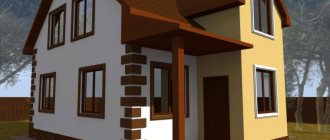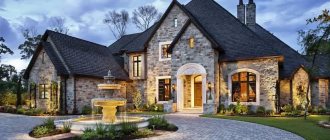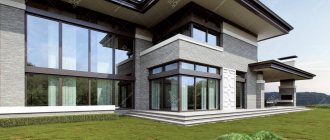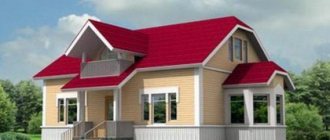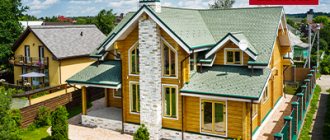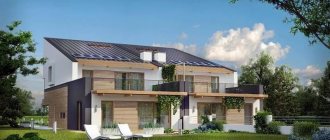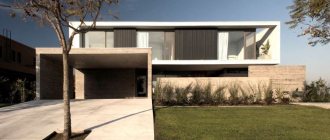Classicism, also known as Palladianism, is an architectural movement based on ancient values and formed in Europe during the High Renaissance. The founder of the style is considered to be the famous architect Andrea Palladio. Having created several serious treatises on the construction and design of buildings in accordance with the canons of style, he also repeatedly applied his knowledge in practice. The most striking example of his work is the Villa Rotunda, dating back to the end of the 16th century.
Classical style in architecture (pictured is Villa Rotunda - a UNESCO World Heritage Site)
Scandinavian style
The style features functionality, plenty of natural light and stylish practicality while maintaining comfort. Scandinavian architecture helps to stay close to nature even in urban environments. The style is dominated by simplicity and conciseness.
The architectural movement arose in countries with a harsh climate similar to Russia’s - Denmark, Sweden, Norway. The facade is made of wood. The cladding is treated with protective compounds to preserve the natural structure of the material. Characteristic features of the buildings: a large porch, a terrace, gable roofs with a steep slope with an asymmetrical or classical shape, large windows or panoramic glazing.
Wooden window frames or double-glazed windows, the finish of which imitates wood, are desirable. The roof is covered with polymer materials or metal tiles. The buildings are distinguished by soft natural shades: terracotta, dark green, gray, brown.
High tech
This is a direction that involves the use of modern materials and stylization of the project as an industrial building. The practical and comfortable style originated in 1970. Architectural objects of this type have metal frames with glass enclosing structures.
Most projects involve the removal of utilities to the façade of the house. Distinctive features of the architectural direction: an abundance of metal structures, simple, clear lines, flat roofs with dark roofing, large windows.
Europe
Classicism was born in Europe. Let's look at the most interesting, from my point of view, buildings in the photo. Queens House, Greenwich, 1636. Great Britain.
East façade of the Louvre, France.
House Flora-Stoeckl, Austria
Victorian style in architecture
The style originated between 1830 and 1910 during the reign of Queen Victoria. Key features: “dollhouse” effect, thoughtful finishing, steep mansard roof covered with tiles, asymmetrical shape, presence of a porch, bright rich colors, balconies with columns, majestic towers and turrets, decorative railings.
Victorian houses are typically two-storey compact buildings with intricate decoration and multi-stage pitched roofs, often decorated with spiers. The stylistic movement originated in Great Britain and spread not only within the country, but also to the English colonies. Houses in this architectural style are distinguished by an asymmetrical facade. For finishing within the stylistic direction, plaster, siding, and brick are used.
Japanese style
The architecture of the Land of the Rising Sun is the result of the centuries-old war between the Japanese and nature. The main features of the style were borrowed from the Chinese.
The basic architectural elements of the Japanese style are not determined by fashion trends, but by vital necessity. Both in ancient times and now, the main principle of architecture remains the unity of buildings and the surrounding nature. Functionality is a priority, while aesthetics take a back seat. Characteristic features of Japanese houses: a small amount of decor, practicality and rationalism.
Previously, in Japan, houses were built from wood and rice paper. Today, fiber cement boards and ceramic siding are used. A special feature of the Japanese style is a terrace with plank flooring. For greater authenticity, the terrace is decorated with container gardening.
What it is
Classical is the heir to ancient architecture. Despite their similarities, it is customary to call a style a classic if it:
- Based on the architecture of antiquity, that is, Ancient Rome and partly Greece.
- It was built after the Renaissance, that is, the Roman building itself will not be called a classic.
The book of De Architecture Vitruvius can rightfully be considered the Bible of style. It was studied back in the Middle Ages, and thus the Renaissance was born. An article about the Renaissance can be read here. Even then, the modest Romanesque style and the Gothic, overly loaded with details, became boring to the average person.
I wanted something simpler, without losing beauty. Andrea Palladio is considered the father of the style; he was the first to adapt the philosophy and monuments of antiquity to the realities of the 17th century.
The Renaissance arrived, when architects found inspiration in the buildings of the Roman Empire and the works of Vitruvius. They adapted them to the expectations of others and people liked them. And where there is adaptation, there is a place for the original.
Following the Renaissance, strict and at the same time sophisticated classics came into fashion. The birthplace of classicism is France and England. When classicism came to Russia, during the time of Catherine the Great, Neoclassicism was already in fashion in Europe. It is believed that Russian classicism is closer to neoclassicism than to classicism.
American style
The style represents adaptive variations of previously existing architectural trends in Europe. From the desire of the early settlers to demonstrate the scale and richness of the house, came the need to create not just modest dwellings, but an entire architectural complex.
The style is distinguished by a minimum of relief details, a predominance of straight lines, symmetry, light calm colors, many windows, horizontal extension, and an asymmetrical roof. Currently, this stylistic direction is a mixture of architectural styles. General concept: build a spacious, comfortable house where everyone will feel comfortable. Usually this is a frame one or two-story house with a low foundation with a veranda or a spacious porch.
Idea
Even architecture could not do without philosophers. What is the idea of a classic?
For starters, philosophers changed the idea of beauty. Before that, in Gothic, Romanesque and partly Renaissance, beauty was a person’s perception of this object.
That is, horses are considered beautiful not because they are objectively beautiful, but because many people consider them beautiful. The main idea in the classics is that beauty is a property of an object, and not a product of the viewer’s perception.
Since beauty is real and not figurative, then it must obey the laws of nature. Beauty is the law of nature, and the law should be as simple as possible. What could be simpler than straight lines? The idea of classics is order, compliance with all proportions, symmetry. If it's a line, then it's straight. If it's an angle, then it's 90 degrees.
We come to the conclusion that art and science are inseparable. Science serves art, and art depicts the laws of science. Then art simply cannot afford to go against science and common sense. A wavy line is illogical, unscientific and cannot exist in the art of classicism.
Having compared all these ideas, philosophers and architects came to the conclusion that such creations already exist. Ancient masters almost completely implemented the philosophy of naturalness, simplicity and harmony. And they called themselves successors, heirs of the ancient style. Hence the name - classic. Immortal ideas.
Country style
The main features of the rustic style are naturalness and simplicity. The direction reflects the folk traditions of its country, is distinguished by deliberate rudeness and closeness to nature.
The rustic-style building looks authentic; natural materials (stone, wood) and natural shades are used in the exterior decoration. Typically, a house in this style is built with a veranda or massive porch. If the building has two floors, a spacious balcony is built above the porch, in harmony with the general style of the facade. Characteristic features of the Russian rustic style: log walls, windows with carved frames.
Video description
The video presents examples of finished interiors in a classic style:
In the kitchen, accessories play a secondary role. In this space, the design of furniture facades comes first. And dishes and kitchen utensils serve as decoration. She usually hides behind glass facades.
The set is a bright accent that helps define the design style Source design-homes.ru
Nothing superfluous - furniture comes first Source dekor.expert
Wright style
The style originated in the USA at the end of the 19th and beginning of the 20th centuries. The founder of the movement was the architect Frank Lloyd Wright. Wright's style is also known as the Prairie style.
Wright advocated clean and simple lines, a building whose exterior was integrated into the surrounding landscape. Prairie-style houses fit seamlessly into the natural setting of a Western film. Key features of the style: long horizontal lines, minimalist decoration of facades, hipped or flat roofs, glazed galleries.
Empire and French classicism
In France, Classicism arose later than in England. Its first phase covers the period from 1750 to 1800. It is expressed in the style of “Louis XVI,” which included the completion of Rococo and the birth of French Classicism.
Classicism in 18th century architecture in France. Church of St. Genevieve, Paris
The second stage is known as the Empire style or Late Classicism, which was distinguished by the solemnity and pomp of memorial architecture and palace interiors.
His other name is
- Imperial style, from the French word empire - empire,
- High classicism or
- Napoleonic style (by period of reign).
The Empire style completes the evolution of classicism in the first three decades of the 19th century.
Arc de Triomphe in Paris.
Its differences - pomp, pomposity, ostentation, festivity - were actively used by Napoleon's French court architects. Appeared in Russia under Alexander I. Correspondences:
- In Britain - Regency style,
- in Germany - Biedermeier or Biedermeier,
- in the USA - federal style.
Watch the video on the topic:
Chalet
The “Alpine house” style is chosen by those who dream of an atmosphere of security, harmony and tranquility.
The direction spread from the ancient province in southeastern France. Buildings in this style are adapted for harsh climates and are therefore optimally suited for Russia. Today, chalets are a relevant and sought-after style for functional country housing.
The cornerstones of the style: a solid stone foundation and a wooden top, the use of high-quality environmentally friendly materials, a sloping roof with a large angle of inclination, a terrace. Another feature is the multi-level architecture, since the original chalets were mainly built in the mountains and followed the uneven terrain. For this reason, chalets fit perfectly into a plot with a significant slope. For the roof of the “shepherd’s house”, flexible, ceramic, and wooden tiles are used to maintain authenticity. The modern housing of alpine shepherds is built on 1-2.5 floors.
Eclecticism in the interior: Features and features
Eclectic interior design is an absolute mishmash of trends. This is an opportunity to infuse your home with a unique and personal signature style.
Eclecticism is often confused with fusion. But these are different styles. Fusion is always bright colors, a combination of incongruous things, a mixture of directions that are inharmonious at first glance. Eclecticism is calm, style and confidence.
The restrained interiors are distinguished by their historicism and classical elements. Modern items fit elegantly into the overall aristocratic style. Eclecticism is not about emotions in the interior. This is status and nobility.
German style
This architectural direction is chosen by those who value solidity, simplicity and elegance. The nuances of designing the facades of buildings in the Bavarian or German style: strict lines, lack of redundancy of decorative elements, restrained colors, use of inexpensive materials.
This style inherits German neatness and desire for order. Despite this, the houses resemble charming fairy-tale houses straight from the pages of fairy tales. German-style buildings are designed in the form of a square or rectangle with a gable roof.
The walls are painted white, sand, gray or other discreet colors. Tile roofs are traditionally made in brown or red. The shape of the windows is rectangular or arched, the glazing is divided into several square or rectangular sections, and the windows are sometimes supplemented with shutters.
Russian classicism
As always, we slightly changed the style to suit ourselves. Classicism came to Russia under Catherine II. All over the world they were already moving away from the classics in favor of the Baroque, a more decorated and elegant style. In our country, on the contrary, classics have replaced baroque.
The style gained popularity due to its simplicity and minimum decoration, at least in the Russian interpretation. Then we actively developed trade, migration and invited specialists from all over the world. It was necessary to quickly, a lot and beautifully build up at least Moscow and St. Petersburg. What decorations are there? If only it didn't look like a barracks!
In total, palaces, hospitals, apartment buildings and shops were built in the classics in Russia. For the buildings of ordinary people, house decorations were used to a minimum, but the style was strictly observed. Let's look at these buildings.
English style
The style is a combination of refined taste and restraint. The cornerstones of the architectural movement: a symmetrical rectangular plan, red brick walls, a low entrance with a portico.
Currently, the architecture of an English mansion is dominated by elements characteristic of the architecture of a particular historical era. Key features of the eclectic style: a roof with a dormer window and a steep slope, low-lying windows, walls made of brick or stone.
Half-timbered
The style originated in the 15th century in Germany. A half-timbered house is an example of German quality and practicality. Buildings in this type of architecture require an external frame of vertical, horizontal and diagonal beams.
Feature of the style: the second floor overhangs the first. The main material of half-timbered houses is wood. Since wooden houses are highly flammable materials and require antifungal treatment, they are currently resorting to imitating half-timbered timber using polyurethane panels that create the impression of wooden beams.
Design features of a wooden house
Specialists who select interior styles for a wooden house highlight the following features of this work:
- Houses built from wood, as a rule, do not need interior wall decoration, since the texture of the main material fits perfectly into any interior.
- Very often, designers, when working on the interior style of a country wooden house, try to preserve and play with the natural structure of wood.
- With the help of tinting and color correction of wood, you can create the desired atmosphere in the room (for example, fill it with warmth and comfort), as well as decorate the interior in the desired style. So, by bleaching the logs and covering them with varnish, you will add rural motifs to the decoration.
- The interior design of a wooden house, made in pastel colors, is typical of the Provencal style.
- In addition to wooden walls, the room traditionally contains other surfaces made of this material: ceiling wooden beams, laminate, parquet or regular plank flooring.
- Natural stone, which is characterized by its high strength and long service life, goes very well with wood surfaces. The coziness created by the warm wooden texture will be enhanced many times over if you complement the interior with comfortable pieces of furniture and a fireplace.
Thanks to its natural attractiveness, the interior of a wooden house can evoke a special dreamy mood in the inhabitants of the home and give a state of peace of mind. The natural grain of wood adds elegance and beauty to surfaces and makes the room unique.
Coordination of work
You need to choose furniture in accordance with the interior style of the wooden house. Very often, experts suggest furnishing a house with objects also made of wood. With this approach, the interior and furniture will be perfectly combined, and the room itself will be filled with comfort and warmth.
If the furniture has been carefully chosen and positioned, it will further emphasize the sophistication of natural wood. From this point of view, wooden furniture is the ideal option; moreover, it allows you to achieve complete harmony between the decor and the interior. The owner of such a home will demonstrate his status and excellent taste to his guests without words.
Gothic style
Gothic houses have their own characteristics: strict geometric shapes, resemblance to a defensive fortress with one to four high towers, a pointed roof, elongated lancet windows, stained glass glazing, modest façade decoration, contrasting color combinations of the roof and walls. The building material of Gothic houses is stone or brick. The buildings have at least 3 floors. Gothic-style houses look authentic on the edge of a forest or in mountainous areas.
Color palette
The color palette is not limited, but there are certain rules.
- Base color. Must be light: white, beige, light gray. All shades of pastel colors are suitable.
- Additional colors. Combining deep tones, dark or medium tones.
- Accent color. It is used rarely and to a minimum - eclecticism does not like bright colors.
An example of a harmonious combination of colors:
| Base color | Additional #1 | Additional No. 2 |
| White | Burgundy | Black |
| Beige | Chocolate | Sky azure |
| Heavenly | Ripe cherry | Mustard |
| Light purple | Dark herbaceous | Dark blue |
| Light pink | Rich purple | Burgundy |
| Lactic | Dark chocolate | Turquoise |
| Light lemon | Dark green | Brown |
| Light gray | Black | Ripe cherry |
| White | Emerald | Dark blue |
| Lactic | Green | Brown |
| Delicate violet | Violet | Black |
The second complementary color is used less than the first.
It is better to use ready-made combinations. This guarantees a beautiful result.
Baroque
Baroque houses look like miniature palaces. The buildings are distinguished by their monumental appearance, abundance of stucco, and intricately decorated facade, reminiscent of buildings of the late Middle Ages. The Baroque style is chosen by fans of classical architecture, connoisseurs of luxury and grace.
Also distinctive characteristics of the architectural direction are pilasters, arched windows, relief cornices, balustrades, a high massive porch, a staircase with railings, decorative cornices under the roof and above the windows. The style involves finishing the facade in cream, white, beige, golden, and gray tones.
Tver
Hotel Galyani on the corner of Volodarsky and Pushkinskaya streets.
Cathedral of the Ascension on Sovetskaya Street.
The building of the Junker Cavalry School on Zhigarev Street.
Modern
Extravagant style rethinks the principles of standard architecture. The originality of this design lies in the combination of building materials such as metal and glass, concrete and stone, a combination of asymmetrical lines and broken shapes.
- The architectural direction is based on a harmonious combination of man-made elements and natural forms, the presence of plant motifs, and the absence of symmetry.
- The style attracts with its polygonal shapes, volumetric architecture, and wavy recesses.
- Architectural modernism combines simplicity of design and a wide choice of colors.
Provence
The style of rural houses of the southern French province originated in the 19th century. The architecture of Provence is in tune with those who know how to see beauty in everyday life. A characteristic feature of the decor in the Provence style is some negligence and aged materials for the external decoration of the facade.
Distinctive features of the style are a high spacious terrace, forged and carved details, wooden shutters and windows, a tiled roof with several slopes, a balcony with columns and balusters, massive doors with metal hinges. External wall decoration is done in light pastel colors. Preference in facade decoration is given to natural materials: wood and stone; with a small budget they are replaced with high-quality imitation.
Casa Batllo
An example of early 20th century Art Nouveau architecture, built in 1877. In 1904-1906, the building was completely rebuilt by the brilliant architect Antonio Gaudi. Both the façade and interiors were reconstructed.
Due to the many design techniques used, the building stands out for its stylistic heterogeneity and is a real Barcelona landmark. The exterior of the house is distinguished by glass mosaic decor, a predominance of asymmetry, natural motifs, religious symbols, colorful pure colors, balconies with railings in the form of the pelvic bones of the human skeleton. Gaudi radically rebuilt the seven-level structure, giving the façade smooth shapes and the roof the silhouette of the arched back of a dragon.
Yaroslavl
An example of a classic here would be Sovetskaya Square, namely the building of the Provincial Government Offices. Built in 1787 in record time per year. This is the first such monumental building in Yaroslavl, because it is the main government building of a large center, they could not have built it otherwise.
On Pervomaiskaya Street you can find Gostiny Dvor. Built in the first quarter of the 19th century to replace the open market. He suffered from fires, reconstruction and shelling during the Second World War. The entire historical concept can no longer be seen, but the rotunda and the preserved northern wing will help you see and understand classicism.
Loft style in architecture
The birthplace of non-standard trends in the interior and exterior design of houses is the USA. Initially, these were factories, warehouses, factories, converted into residential premises. Loft objects have an industrial, authentic look.
Conceptual features of the architectural style:
- Dirty gray, red-brown color scheme and metallic shades.
- Strict lines and simplicity of geometric shapes with minimal decoration.
- Fragments of industrial structures in the form of metal stairs, factory pipes, ventilation systems.
- Unusual combinations of aged red brick and panoramic glazing, raw or roughly plastered concrete and ferrous metal for a residential building.
Loft-style houses are preferred by creative individuals with an unconventional approach to life. Architectural objects that claim to belong to the Loft are distinguished by extraordinary exteriors that refer to the industrial past.
Briefly about the main thing
Decorating a house in a classic style depends on the initial tasks. If you want traditional classics, then you will have to develop a design project in which both the exterior and the interior are built according to the principle of strict symmetry.
The colors used are discreet, pastel, and a combination of white and gold is often used.
The furniture is made from natural wood of expensive species. Its shape is wavy, curved legs are always present, and the facades are decorated with ornate decor. For upholstery of soft sets, expensive fabrics or leather are chosen.
Elegant luxury, an abundance of expensive decor, antique accessories - all these are traditional classics.
Ratings 0
Minimalism
A classic minimalist home is a small house with a simple, symmetrical design. This style direction is characterized by the absence of decorative elements and maximum simplicity of lines, geometric shapes and natural textures. Style concept: cut off everything unnecessary and leave the rational.
The main features of houses in the minimalist style: large window openings, a horizontal roof, a combination of vertical and horizontal lines. The basic colors of such architectural objects are light and neutral. The geometric nature of the architectural solution is emphasized by black. Dwellings in a minimalist style are built on one or two floors. Materials used in construction: concrete and glass; natural wooden boards and clinker tiles are used for finishing.
Examples of modern styles of houses and cottages
In total, there are more than 40 styles in its pure form for building a country house. Added to this number is a large number of mixed architectural movements. The choice of a specific style often depends on the size of the home.
For example, if you build a small home with ambitious marble columns at the entrance or high arched windows, it will create disharmony. All elements must be proportional and visually balanced. To understand what a home should be like, let’s consider several popular style options.
Provence
Cottages or private houses in the Provence style have a unique harmony of charm, love for everything traditional, conservative and rural simplicity. Inside, the wooden beams are completely exposed. They are painted, varnished or whitewashed.
Interior of a wooden house in Provence style - beams, white painted ceiling and wall surfaces Source arxip.com
Exterior design may vary, but it always evokes quiet rural life. Some houses are simply brick or stone without finishing. Others are plastered, painted in light colors and decorated with contrasting elements of the protruding frame. The following solutions are very popular:
- white walls and blue frame beams and window shutters;
- beige stonework and light brown roofing.
A whitewashed or white-painted house in the Provence style Source michaelzingraf.com
Characteristic features of the exteriors of houses in Provence:
- Mandatory presence of windows with projections directly from the roofs (bay windows). There are also fancy options where such a window occupies part of the facade wall and part of the roof along the vertical plane.
- Chimneys of fireplaces or stoves run along the side external walls.
- The shape of door and window openings is simple straight or arched.
- A small terrace, balcony or veranda is allowed.
When building houses in the Provence style, only natural building materials must be used. This is wood, stone, clay, ceramic tiles, whitewash. The house must have neat garden paths paved. Everything is decorated with a large number of baskets and pots with fresh flowers.
The simplicity of the stonework peeking out from under the plaster, high chimneys, bay windows - classic Provence Source domikarkas.ru
Classical
The classic style of architecture of a country house or cottage can also be called European. Strictness of form, lack of frills in decor, simplicity and functionality are the main things that distinguish this solution from others.
Style features:
- The shape of the building is square, rectangular.
- Decor - complex bay windows of the attic floors, inserts and stones, lanterns or lamps.
- The roof can be either 2 or 4 pitched.
- Number of floors - from 1 to 3-4 floors (also ground floor).
- Roofing material – metal tiles.
- The shape of windows and doorways is straight or arched.
- The window size is average.
- The facade finishing material is facing brick, plaster.
The cladding of the ground floor is laid out with stone, the rest of the house is plastered or painted.
A house in a classic style has strict straight and orderly lines, simple designs, neutral tones and a minimum of decor. Source avk-project.com
See also: Catalog of projects of houses and cottages presented at the exhibition “Low-Rise Country”.
Modern
The style of the exterior of country houses arose at the junction of times - the end of the 19th and beginning of the 20th centuries. He is still loved by those who are accustomed to adhering to a sense of proportion in everything. Projects for such dwellings may already allow ornate decor or contours of facade elements to dilute strict lines.
The facade of the house is made with interesting three-level smooth curves, complemented by an interesting edging - white stucco. Source fotostrana.ru
Features in detail:
- Suitable for large and small families.
- Creative people will like it.
- Filling the design with smooth lines, curves, and rounded corners, where possible, is encouraged here.
- The contrast of shades is complemented by a third color. It focuses attention on a specific area.
- Instead of symmetry, a tendency towards naturalness is used.
- Finishing materials – brick, stone, tiles (glazed ceramics), plaster, paint, stained glass and mosaics.
- Decor – stucco with plant and animal ornaments, forged metal elements.
- Complex internal layout - grouping of rooms around a large hall.
Rounding is used in arched structures of windows and doorways. Grace finds itself in the design of barriers for balconies, steps, and stairs. The columns of the terraces or the front entrance can be asymmetrical in shape with smooth curves. An interesting approach to roofing - some parts of the house have a dome-shaped roof, where its edges hang directly onto the walls.
The house is designed with a lot of smoothly curved surfaces Source moreremonta.info
The color scheme of houses or cottages in the Art Nouveau style is filled with calm, but always contrasting shades. The following combinations are popular now:
- dark brown, muted yellow and brown with a hint of burgundy;
- red brick, white plaster and bluish stucco on a light background;
- completely monochromatic light facade and massive dark roof;
- a play of all shades of brown - from light to dark, complemented by gold-tinted glass;
- sand facade, cream foundation and decorative framing of arched passages, door frames, windows.
The result is an ideal combination of brevity, geometric shapes and fancy solutions (turrets, round windows, graceful steps).
Chalet
The style of a country house - chalet - is characterized by a combination of stonework, brick and wooden elements. The name comes from the French Alps. The first “chalets” were small buildings that provided short shelter from the winter cold in the mountains. Subsequently, they became typical multi-level village houses, which are installed on an uneven mountainous surface.
A building on a stone foundation with a completely wooden second floor Source uutvdome.ru
See also: Catalog of companies that specialize in the design and construction of turnkey country houses.
Main differences:
- Fits well into hilly, mountainous and wooded landscapes.
- The lower part is made of stone, the upper part is made of wood or trimmed with solid wood.
- The roof is always gable with a canopy hanging strongly in front. This helps protect your home from snow storms.
- The roof covering is tiles made from natural materials or shingles made from heavy-duty tree species (larch, cedar).
- Wall decoration - facing with wild stone, brick or rough whitewash.
- The presence of terraces and balconies on supports. Everything is made from wood.
- Some projects include large panoramic windows, others have small ones with shutters, typical for a village home.
- Profiles of double-glazed windows are made of wood only.
- Number of storeys – 2 and less often 3-storey houses and cottages.
Style has its own directions. They were formed under the influence of ethnicity, culture, and climate of different Western countries. The following chalet options are available:
- Scandinavian;
- Belgian;
- German;
- English;
- American.
Modern design of a multi-level house in the German chalet style, typical for mountainous and hilly areas Source avatars.mds.yandex.net
The second name, which summarizes all the mentioned branches, is Alpine style. Everything here is so practical that even the decor is practical. For example, the crossbars of balcony barriers are often used for hanging flower pots on them in the warm season. Wooden profiles and beams - for hanging street lamps on them, and kitchen utensils indoors.
Russian architectural style
A cottage or private country house in the Russian style must be built from strong logs. If such a solution turns out to be too expensive, then new generation technologies are used - block houses. Thanks to this solution, the house is also built from wood, but with the imitation of a full-fledged log house.
The house can be completely wooden. But there are options when the ground floor is made of stone or brick. Russians have long had large families. The lower tier always housed the so-called public rooms - for example, a large kitchen. The lower tier is the basement or first floor, depending on the regional characteristics of the soil and climate.
Wood is also usually used as decor. These are various threaded elements - pillars, barriers, facade balusters (for steps, balconies, terraces). Wooden shutters are always decorated with typical carvings, repeating Russian ornaments, plant, animal or fairy-tale patterns.
A log house with a spacious terrace, extended from the facade into the distance, decorated with wood carvings, pillars and shutters Source avatars.mds.yandex.net
Interestingly, the carving can be either voluminous, relief, or through. The last option from a distance strongly resembles lace. Such decorating techniques are used to decorate cornices, brackets or roof overhangs, fences, and interfloor overhangs. No two houses are alike. Every Russian home is unique.
Roman style
Monastic or fortress styles of country houses over time transformed into a solid and massive Romanesque style. Here you can easily discern the fusion of several directions - the classics of the Renaissance, Gothic and the fortified inaccessibility of the chateau.
House-palace with Gothic elements when arranging the roof. The chateau style is given away by the castle tower and chimneys Source avatars.mds.yandex.net
Features of the Romanesque concept:
- Everything is made of rough stones.
- The exterior decoration is modest, without decoration. Everything resembles a fortress or a fort.
- Architectural forms tend towards rigor without frills.
- The walls and roof are massive.
- The window openings are narrow.
- The steps are recessed under the arches and run between the pillars.
- Hexagonal, round, and other roof options are covered with tiles.
- The shades of the façade are always close to natural.
Often such houses are decorated with entwined ivy, interesting balusters of balconies, and a few stone statues. All outbuildings must be attached to the house.
